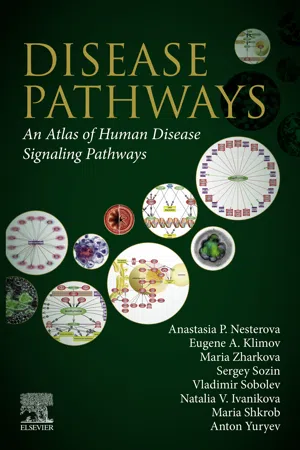
Disease Pathways
An Atlas of Human Disease Signaling Pathways
- 732 pages
- English
- ePUB (mobile friendly)
- Available on iOS & Android
Disease Pathways
An Atlas of Human Disease Signaling Pathways
About This Book
Disease Pathways: An Atlas of Human Disease Signaling Pathways is designed to fill a void of illustrated reviews about the cellular mechanisms of human diseases. It covers 42 of the most common non-oncologic diseases and illustrates the connections between the molecular causes of the disease and its symptoms. This resource provides readers with detailed information about the disease molecular pathways, while keeping the presentation simple.
Pathway models that aggregate the knowledge about protein–protein interactions have become indispensable tools in many areas of molecular biology, pharmacology, and medicine. In addition to disease pathways, the book includes a comprehensive overview of molecular signaling biology and application of pathway models in the analysis of big data for drug discovery and personalized medicine.
This is a must-have reference for general biologists, biochemists, students, medical workers, and everyone interested in the cellular and molecular mechanisms of human disease.
- Over 145 full-color illustrations of the molecular and cellular cascades underlying the disease pathology.
- Disease pathways are based on computational models from Elsevier's Disease Pathway Collection, published for the first time outside of Pathway Studio® commercial software.
- Each relationship on the pathway models is supported by references to scientific articles and can be examined at freely available online resources.
Frequently asked questions
Information
Infectious diseases
Abstract
Keywords

Human immunodeficiency virus (HIV) and acquired immunodeficiency syndrome (AIDS)

Table of contents
- Cover image
- Title page
- Table of Contents
- Copyright
- Contributors
- Foreword: The future of medical discovery
- Preface
- Guide and legend
- I: Introduction
- II: Human disease pathways
- III: Pathway analysis perspectives/advantages
- Glossary and index
- Links
- Index